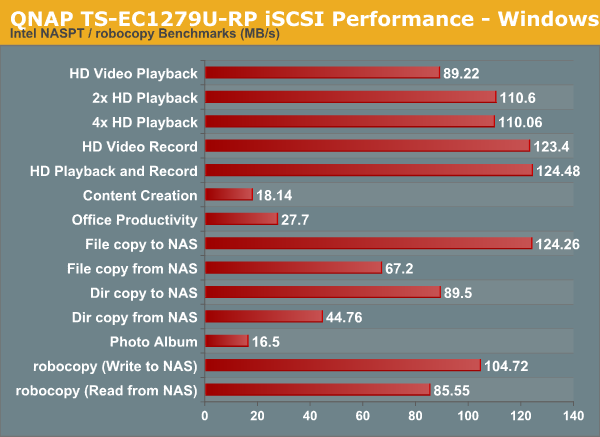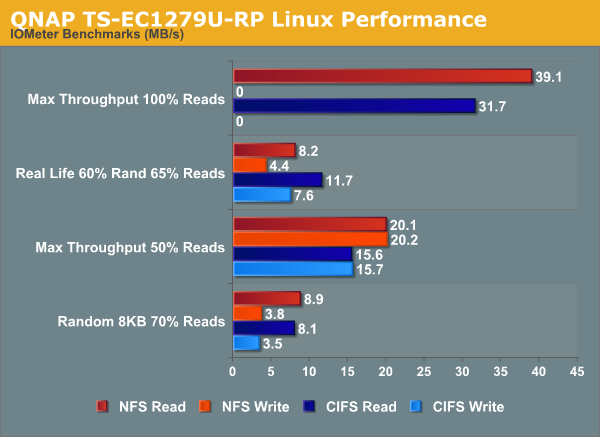QNAP's TS-EC1279U-RP 12-bay Flagship Rackmount NAS Review
by Ganesh T S on April 29, 2013 4:30 PM EST- Posted in
- Enterprise
- Storage
- NAS
- QNAP
Single Client Performance - CIFS, NFS and iSCSI
The single client CIFS performance of the QNAP TS-EC1279U-RP was evaluated on the Windows platforms using Intel NASPT and our standard robocopy benchmark. This was run from one of the virtual machines in our NAS testbed. All data for the robocopy benchmark on the client side was put in a RAM disk (created using OSFMount) to ensure that the client's storage system shortcomings wouldn't affect the benchmark results

We created a 250 GB iSCSI target and mapped it on the Windows VM. The same benchmarks were run and the results are presented below.

A CentOS 6.2 virtual machine was used to evaluate NFS and CIFS performance of the NAS when accessed from a Linux client. In order to standardize the testing across multiple NAS units, the following parameters were used to mount the NFS and Samba shares:
mount -t nfs NAS_IP:/PATH_TO_NFS_SHARE /PATH_TO_LOCAL_MOUNT_FOLDER -o async,hard,proto=tcp,noac
mount -t cifs //NAS_IP/PATH_TO_SMB_SHARE /PATH_TO_LOCAL_MOUNT_FOLDER -o directio
Note that we have not tried to optimize NFS performance for the NAS. In order to keep things as uniform as possible, we will just look at comparative performance on the basis of the default mounting options combined with the above (which are set to avoid caching effects on the client side). The scripts available here were run on IOMeter. The graph below presents the various results.











23 Comments
View All Comments
Jeff7181 - Tuesday, April 30, 2013 - link
EMC, Hitachi and NetApp provide enterprise class NAS and SAN arrays. This, nor any, QNAP product is anywhere near that level.Walkeer - Thursday, May 9, 2013 - link
agreed, plus NAS is not really enterprise anyway since these is SANdavegraham - Tuesday, April 30, 2013 - link
Ganesh,having worked in the storage industry (and now working for an enterprise and carrier networking company doing data center architecture and design) QNAP, Drobo, et al. aren't names that carry any weight for enterprise-class storage. The systems I deal with (for example, EMC Symmetrix VMAX 40K) are considered "enterprise class" storage systems (99.999% uptime, SSD caching and tiering, finely tuned atomic memory and storage access, multiple active processing storage engines/directors, fibre channel/FCoE/iSCSI front ends, extensive API command/control sets, replication [local & remote], snapshotting/cloning, etc.). As Jeff7181 notes below, these stand alone in a class by themselves.
cheers,
D
Walkeer - Thursday, May 9, 2013 - link
agreed, this is a SOHO toy...jaziniho - Wednesday, May 1, 2013 - link
Unless this comes in a model with dual controllers (not just dual PSUs), then it's squarely in the SMB rather than enterprise space.Support for SAS as well as SATA disks would also be high on list of potential requirements for enterprise. With RAID rebuild times on large drives so long, you need disks with decent reliability to give you more confidence in making it through the rebuild.
aloginame - Saturday, May 11, 2013 - link
I agree with the fact that this QNAP is not really a "Enterprise" or "High-End" solution for NAS, however, I have to disagree when it is being compared to something like EMC Symmetrix VMAX 40K, for those are really SAN solutions and not NAS.golemite - Monday, April 29, 2013 - link
Hi Ganesh, any chance of getting reviews of lower end rackmount NAS systems like the Synology RS812/812+?ganeshts - Wednesday, May 1, 2013 - link
We have the Synology RS10613sx+ in the pipeline, but it costs approx. twice that of the TS-EC1279U-RP and caters to users who require more performance / features.mmayrand - Tuesday, April 30, 2013 - link
So, you spend $3500 for box plus 12 SSD (not free) and you get the 1/3 of the effective bandwidth of a single SSD plugged in a $300 PC. Is there a point to these NAS boxes?davegraham - Tuesday, April 30, 2013 - link
Mmayrand,the concept behind a NAS box is shareable storage across N-number of users in a SoHo or SMB environment. at that point, it makes more sense to have a common pool of storage that can be "protected" (remember, RAID is NOT backup) and utilized more efficiently, than a scattered or siloed collection of independent disk in a laptop or desktop.
it also is a basic requirement for most virtualization (the concept of shared storage) solutions to maintain high availability and portability for virtual machines within a cluster. As a standalone box, you're right, you can hit better performance #'s because you're just straddling a PCIe bus vs. ethernet. however, change the venue and you're looking at a more ideal solution.
D